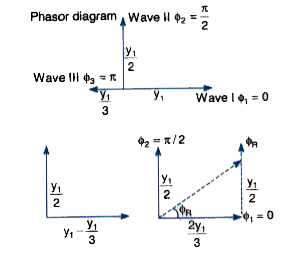Three sinusoidal waves of the same frequency travel along a string in the positive direction of x axis. Their amplitudes are y1,y12andy13, and their phase constants are 0,π2, and π respectivey, What are (a) the amplitude and (b) the phase constant of the resultant wave ?
Phasor diagram Wave || ϕ2=π2

AR=√(2y13)2+(y12)2=y1√49+14=56y1
ϕR=tan−1(y1/22y1/3)=tan−1(3/4)=37∘
The phase constant of the resultant wave with respect to first wave is 370.
Topper's Solved these Questions
- WAVE MOTION AND SOUNDBOOK - AAKASH SERIESCHAPTER - WAVE MOTION AND SOUNDEXERCISE - EXERCISE (LONG ANSWER QUESTIONS)
1 Videos
- WAVE MOTION AND SOUNDBOOK - AAKASH SERIESCHAPTER - WAVE MOTION AND SOUNDEXERCISE - EXERCISE (VERY SHORT ANSWER QUESTIONS)
25 Videos
- WAVE MOTIONBOOK - AAKASH SERIESCHAPTER - WAVE MOTIONEXERCISE - PRACTICE SHEET ADVANCED (INTEGER TYPE QUESTIONS)
10 Videos
- WAVE OPTICSBOOK - AAKASH SERIESCHAPTER - WAVE OPTICSEXERCISE - PROBLEMS (LEVEL - II)
20 Videos
Similar Questions
Two sinusoidal waves y1,(x,t)andy2(x,t) have the same wavelength and travel together in the same direction along a string. Their amplitudes are ym1= 4.0 mm and ym2=3.0mm, and their phase constants are 0 and π/3 rad, respectively. What are the amplitude ym', and phase constant of the resultant wave? Write the resultant wave in the form of Eq. 16-63.
View SolutionThree component sinusoidal waves progressing in the same directions along the same path have the same period byt their amplitudes are A,A2andA3. The phases of the variation at any position x on their path at time t=0are0,−π2and−π respectively. Find the amplitude and phase of the resultant wave.
View Solution
Knowledge Check
Five sinusoidal waves have the same frequency 500Hz but their amplitudes are in the ratio 2:1/2:1/2:1:1 and their phase angles 0,π/6,π/3,π/2andπ, respectively . The phase angle of resultant wave obtained by the superposition of these five waves is
A30∘B45∘C60∘D90∘Five sinusoidal waves have the same frequency 500Hz but their amplitudes are in the ratio 2:1/2:1/2:1:1 and their phase angles 0,π/6,π/3,π/2andπ, respectively . The phase angle of resultant wave obtained by the superposition of these five waves is
A30∘B45∘C60∘D90∘
Three component sinusoidal waves progressing in the same directions along the same path have the same period byt their amplitudes are A,A2andA3. The phases of the variation at any position x on their path at time t=0are0,−π2and−π respectively. Find the amplitude and phase of the resultant wave.
View SolutionThree sinusodal waves having amplitudes a, a/2 and a/3 are superposed. They have the same period and thelr phase are 0, π/2 and respectively. Find (i) The resultant amplitude and phase (ii) Draw a sketch to show the resultant wave.
View SolutionDetermine the amplitudes of the resultant motion when two sinusoidal waves of same frequency , travelling in the same direction are combined . Their amplitudes are 3.0cmand4.0cm and they differ in phase by π/2radians.
View SolutionDetermine the amplitudes of the resultant motion when two sinusoidal waves of same frequency , travelling in the same direction are combined . Their amplitudes are 3.0cmand4.0cm and they differ in phase by π/2radians.
View SolutionTwo sinusoidal wave having the same frequency and travelling in the same direction are combined. What is the amplitude of the resultant motion if their amplitudes are 3cm and 4cm and they differ in phase by π/2 radian?
View SolutionTwo sinusoidal waves of the same frequency travel in the same direction along a string. If ym1=2.0cm,ym2=4.0cm,ϕ1=0,andϕ2=π/2rad, what is the amplitude of the resultant wave?
View Solution
